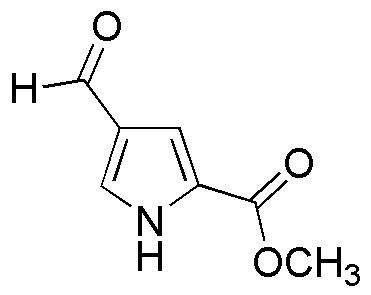Methyl 4-formyl-1H-pyrrole-2-carboxylate is widely utilized in research focused on:
- Synthesis of Pharmaceutical Compounds: This chemical serves as an important intermediate in the synthesis of various pharmaceuticals, particularly in the development of anti-inflammatory and anti-cancer drugs, enhancing therapeutic options for patients.
- Organic Electronics: It is used in the fabrication of organic semiconductors, which are crucial for the development of flexible electronic devices, such as organic light-emitting diodes (OLEDs) and organic photovoltaic cells, promoting advancements in sustainable energy solutions.
- Material Science: The compound is employed in creating novel polymer materials with enhanced properties, such as improved thermal stability and mechanical strength, which are beneficial in various industrial applications.
- Biological Research: Researchers utilize this chemical in the study of biological systems, particularly in the exploration of enzyme activity and metabolic pathways, providing insights into cellular processes and potential therapeutic targets.
- Flavor and Fragrance Industry: It is also used in the formulation of flavoring agents and fragrances, contributing to the development of new products in the food and cosmetic industries, enhancing consumer experiences.
Informations générales
Propriétés
Sécurité et réglementation
Applications
Methyl 4-formyl-1H-pyrrole-2-carboxylate is widely utilized in research focused on:
- Synthesis of Pharmaceutical Compounds: This chemical serves as an important intermediate in the synthesis of various pharmaceuticals, particularly in the development of anti-inflammatory and anti-cancer drugs, enhancing therapeutic options for patients.
- Organic Electronics: It is used in the fabrication of organic semiconductors, which are crucial for the development of flexible electronic devices, such as organic light-emitting diodes (OLEDs) and organic photovoltaic cells, promoting advancements in sustainable energy solutions.
- Material Science: The compound is employed in creating novel polymer materials with enhanced properties, such as improved thermal stability and mechanical strength, which are beneficial in various industrial applications.
- Biological Research: Researchers utilize this chemical in the study of biological systems, particularly in the exploration of enzyme activity and metabolic pathways, providing insights into cellular processes and potential therapeutic targets.
- Flavor and Fragrance Industry: It is also used in the formulation of flavoring agents and fragrances, contributing to the development of new products in the food and cosmetic industries, enhancing consumer experiences.
Documents
Fiches de données de sécurité (FDS)
La FDS fournit des informations de sécurité complètes sur la manipulation, le stockage et l’élimination du produit.
Spécifications du produit (PS)
Le PS fournit une description complète des propriétés du produit, notamment sa composition chimique, son état physique, sa pureté et les exigences de stockage. Il détaille également les plages de qualité acceptables et les applications prévues du produit.
Certificats d'analyse (COA)
Recherchez des certificats d'analyse (COA) en saisissant le numéro de lot du produit. Les numéros de lot et de lot se trouvent sur l'étiquette d'un produit, après les mots « Lot » ou « Lot de fabrication ».
Numéro de catalogue
Numéro de lot/série
Certificats d'origine (COO)
Ce certificat d'exploitation confirme le pays dans lequel le produit a été fabriqué, et détaille également les matériaux et composants utilisés et s'il est issu de sources naturelles, synthétiques ou autres sources spécifiques. Ce certificat peut être requis pour les douanes, le commerce et la conformité réglementaire.
Numéro de catalogue
Numéro de lot/série
Fiches de données de sécurité (FDS)
La FDS fournit des informations de sécurité complètes sur la manipulation, le stockage et l’élimination du produit.
DownloadSpécifications du produit (PS)
Le PS fournit une description complète des propriétés du produit, notamment sa composition chimique, son état physique, sa pureté et les exigences de stockage. Il détaille également les plages de qualité acceptables et les applications prévues du produit.
DownloadCertificats d'analyse (COA)
Recherchez des certificats d'analyse (COA) en saisissant le numéro de lot du produit. Les numéros de lot et de lot se trouvent sur l'étiquette d'un produit, après les mots « Lot » ou « Lot de fabrication ».
Numéro de catalogue
Numéro de lot/série
Certificats d'origine (COO)
Ce certificat d'exploitation confirme le pays dans lequel le produit a été fabriqué, et détaille également les matériaux et composants utilisés et s'il est issu de sources naturelles, synthétiques ou autres sources spécifiques. Ce certificat peut être requis pour les douanes, le commerce et la conformité réglementaire.


